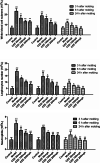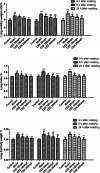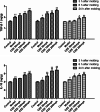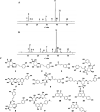Protective effect of Chrysanthemum morifolium Ramat. ethanol extract on lipopolysaccharide induced acute lung injury in mice
- PMID: 32711512
- PMCID: PMC7381867
- DOI: 10.1186/s12906-020-03017-z
Protective effect of Chrysanthemum morifolium Ramat. ethanol extract on lipopolysaccharide induced acute lung injury in mice
Abstract
Background: To evaluate the effect of Chrysanthemum morifolium Ramat. ethanol extract (CEE) on lipopolysaccharide induced acute lung injury in mice.
Methods: The ninety C57BL/6 J male mice randomly divided into five groups: control, model and CEE (50, 100, 200 mg/kg) groups for 7 days oral administration. At the last administration, all mice except control were intratracheal instilled with lipopolysaccharide (LPS, 3 mg/kg) for establish the acute lung injury. Then lung histopathologic, lung wet/dry weight, white blood cells, lymphocytes, neutrophils were detected. The pro-inflammation cytokine tumor necrosis factor-α (TNF-α), interleukin (IL)-6, anti-inflammatory cytokine transforming growth factor-β1 (TGF-β1), IL-10 and the marker of antioxides ability total-antioxidant capacity (T-AOC), malondialdehyde (MDA) in lung tissue were measured.
Results: The result showed that CEE could improve lung histopathological injury, reduce the ratio of wet/dry lung weight and lung index, inhibit the increased number of white blood cells, lymphocytes and neutrophils, and reduce the increased levels of TNF-α and IL-6. While CEE also significantly increased the levels of TGF-β1 and IL-10. Furthermore, CEE also markedly increased the activity of T-AOC, and decreased the contents of MDA with a dose-dependent manner.
Conclusions: The study exhibited that CEE has a potential protective effect on lipopolysaccharide induced acute lung injury in mice, the action mechanism of CEE may through balance of the pro-inflammatory and anti-inflammatory factors, and the oxygen free radicals inhibition.
Keywords: Acute lung injury; Chrysanthemum morifolium Ramat. ethanol extract; Lipopolysaccharide; Total flavonoids; Total triterpenoids.
Conflict of interest statement
The authors declare that they have no conflict interest.
Figures





Similar articles
-
Anti-inflammatory action of Athyrium multidentatum extract suppresses the LPS-induced TLR4 signaling pathway.J Ethnopharmacol. 2018 May 10;217:220-227. doi: 10.1016/j.jep.2018.02.031. Epub 2018 Feb 21. J Ethnopharmacol. 2018. PMID: 29476961
-
Anti-inflammatory effects of water extract of Taraxacum mongolicum hand.-Mazz on lipopolysaccharide-induced inflammation in acute lung injury by suppressing PI3K/Akt/mTOR signaling pathway.J Ethnopharmacol. 2015 Jun 20;168:349-55. doi: 10.1016/j.jep.2015.03.068. Epub 2015 Apr 8. J Ethnopharmacol. 2015. PMID: 25861954
-
Protective effects of Rabdosia japonica var. glaucocalyx extract on lipopolysaccharide-induced acute lung injury in mice.Chin J Nat Med. 2015 Oct;13(10):767-75. doi: 10.1016/S1875-5364(15)30077-7. Chin J Nat Med. 2015. PMID: 26481377
-
Review of polysaccharides from Chrysanthemum morifolium Ramat.: Extraction, purification, structural characteristics, health benefits, structural-activity relationships and applications.Int J Biol Macromol. 2024 Oct;278(Pt 3):134919. doi: 10.1016/j.ijbiomac.2024.134919. Epub 2024 Aug 22. Int J Biol Macromol. 2024. PMID: 39179070 Review.
-
Research progress on pharmacological effects against liver and eye diseases of flavonoids present in Chrysanthum indicum L., Chrysanthemum morifolium Ramat., Buddleja officinalis Maxim. and Sophora japonica L.J Ethnopharmacol. 2025 Feb 10;338(Pt 2):119094. doi: 10.1016/j.jep.2024.119094. Epub 2024 Nov 10. J Ethnopharmacol. 2025. PMID: 39532220 Review.
Cited by
-
Traditional Chinese herbs and natural products in hyperuricemia-induced chronic kidney disease.Front Pharmacol. 2022 Aug 9;13:971032. doi: 10.3389/fphar.2022.971032. eCollection 2022. Front Pharmacol. 2022. PMID: 36016570 Free PMC article. Review.
-
miR-346 regulates the development of ARDS by regulating the function of pulmonary microvascular endothelial cells.Noncoding RNA Res. 2023 Aug 18;8(4):579-588. doi: 10.1016/j.ncrna.2023.08.006. eCollection 2023 Dec. Noncoding RNA Res. 2023. PMID: 37622060 Free PMC article.
-
Fast and efficient identification of hyaluronidase specific inhibitors from Chrysanthemum morifolium Ramat. using UF-LC-MS technique and their anti-inflammation effect in macrophages.Heliyon. 2023 Feb 14;9(2):e13709. doi: 10.1016/j.heliyon.2023.e13709. eCollection 2023 Feb. Heliyon. 2023. PMID: 36852058 Free PMC article.
-
Development and Application of a Cultivar-Specific Sequence-Characterized Amplified Region (SCAR) Marker for the Detection of Chrysanthemum morifolium Ramat. 'Daboju'.Plants (Basel). 2022 Feb 24;11(5):604. doi: 10.3390/plants11050604. Plants (Basel). 2022. PMID: 35270074 Free PMC article.
-
Determination of the synergistic anti-influenza effect of Huangqin Su tablet and Oseltamivir and investigation of mechanism of the tablet based on gut microbiota and network pharmacology.BMC Complement Med Ther. 2023 Feb 4;23(1):36. doi: 10.1186/s12906-023-03858-4. BMC Complement Med Ther. 2023. PMID: 36739385 Free PMC article.
References
-
- Chen M, Lu J, Chen Q, Cheng L, Geng Y, Jiang H, Wang X. Statin in the treatment of ALI/ARDS: a systematic review and meta-analysis based on international databases. Zhonghua Wei Zhong Bing Ji Jiu Yi Xue. 2017;29(1):51–56. - PubMed
-
- Prasertsan P, Anuntaseree W, Ruangnapa K, Saelim K, Geater A. Severity and mortality predictors of pediatric acute respiratory distress syndrome according to the pediatric acute lung injury consensus conference definition. Pediatric Crit Care Med. 2019;20(10):e464–e472. doi: 10.1097/PCC.0000000000002055. - DOI - PubMed
MeSH terms
Substances
LinkOut - more resources
Full Text Sources

